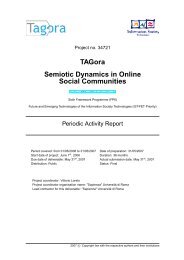NoiseTube: Measuring and mapping noise pollution with mobile ...
NoiseTube: Measuring and mapping noise pollution with mobile ...
NoiseTube: Measuring and mapping noise pollution with mobile ...
Create successful ePaper yourself
Turn your PDF publications into a flip-book with our unique Google optimized e-Paper software.
2.2 Traditional measuring approach<br />
Nowadays <strong>noise</strong> assessments in urban areas are usually carried out by officials<br />
who collect data at a sparse set of locations, e.g. close to roads, railways,<br />
airports <strong>and</strong> industrial estates, by setting up sound level meters during<br />
a short period of time. Propagation models are then used to generate<br />
<strong>noise</strong> maps by extrapolating local measurements to wider areas. This practice<br />
has a number of limitations:<br />
Spatio-temporal data granularity: computational models often produce<br />
results <strong>with</strong> an unknown error margin, which may lead to incorrect conclusions<br />
regarding caused uncomfort [16]. As stated by the EU practise guide<br />
[13] real data <strong>with</strong> high granularity in both time <strong>and</strong> space is required.<br />
However, data collection at sparse locations hardly scales to meet such requirements.<br />
Furthermore, strategic <strong>noise</strong> <strong>mapping</strong> only allows detecting<br />
general <strong>noise</strong> conditions. How can we monitor unusual local or short-term<br />
<strong>noise</strong> <strong>pollution</strong>?<br />
Cost: the cost of such <strong>noise</strong> <strong>mapping</strong> campaigns is high due to the need<br />
of expertise <strong>and</strong> human resources, the deployment of expensive sound<br />
level meter equipment <strong>and</strong> the processing effort. This restricts cities <strong>with</strong><br />
limited budgets from conducting such assessments.<br />
Public <strong>noise</strong> exposure assessment: the EU practise guide [13] requires<br />
detailed assessment of the level of <strong>noise</strong> citizens are actually exposed to.<br />
However, few efforts have been done to combine <strong>noise</strong> <strong>mapping</strong> <strong>and</strong> population<br />
data to assess the <strong>noise</strong> exposure of citizens [26].<br />
Indoor <strong>noise</strong> assessment: current <strong>noise</strong> <strong>mapping</strong> only covers environmental<br />
<strong>noise</strong>, i.e. outdoor <strong>noise</strong>. However, most people spend a significant<br />
portion of their time indoors.<br />
Fig. 1. Official <strong>noise</strong> map of Paris generated using a propagation model <strong>and</strong> measurements made at<br />
a limited number of locations <strong>and</strong> times. Quiet areas are coloured in green while noisy places are in<br />
purple. Gray areas represent places for which no information is available (e.g. in buildings).




